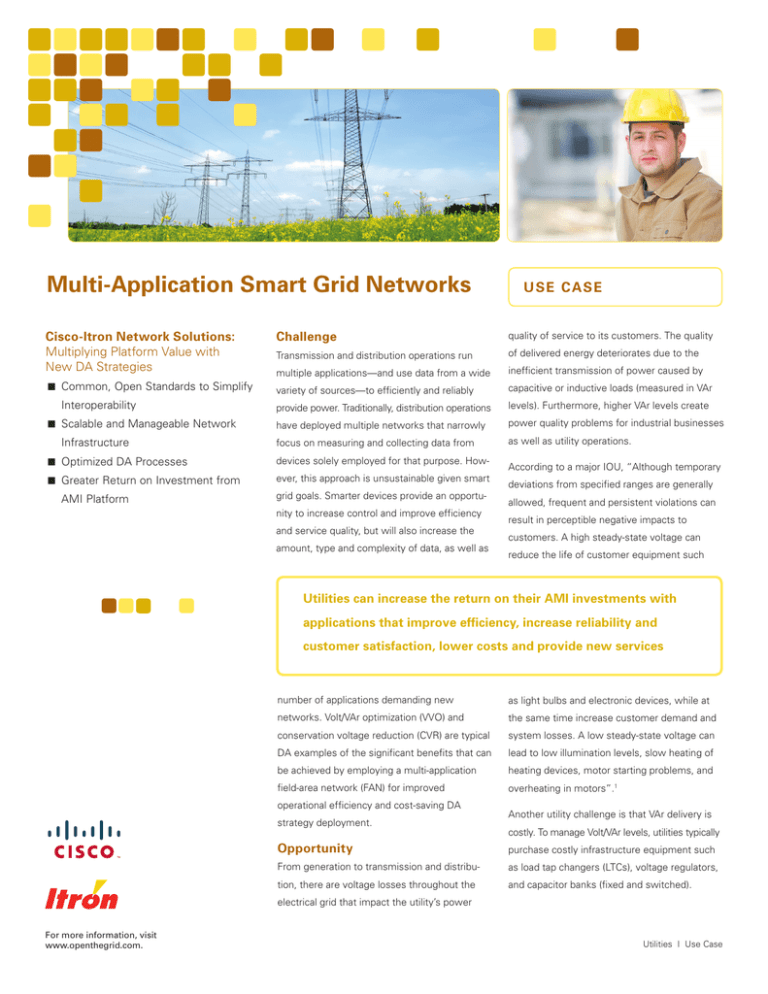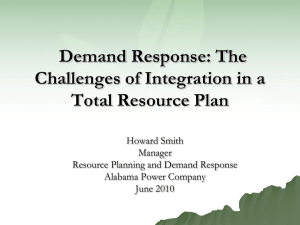
Multi-Application Smart Grid Networks
U S E C AS E
Cisco-Itron Network Solutions:
Multiplying Platform Value with
New DA Strategies
Challenge
quality of service to its customers. The quality
Transmission and distribution operations run
of delivered energy deteriorates due to the
multiple applications—and use data from a wide
inefficient transmission of power caused by
■■ Common, Open Standards to Simplify
variety of sources—to efficiently and reliably
capacitive or inductive loads (measured in VAr
provide power. Traditionally, distribution operations
levels). Furthermore, higher VAr levels create
have deployed multiple networks that narrowly
power quality problems for industrial businesses
focus on measuring and collecting data from
as well as utility operations.
Interoperability
■■ Scalable and Manageable Network
Infrastructure
■■ Optimized DA Processes
devices solely employed for that purpose. How-
■■ Greater Return on Investment from
ever, this approach is unsustainable given smart
AMI Platform
grid goals. Smarter devices provide an opportunity to increase control and improve efficiency
and service quality, but will also increase the
amount, type and complexity of data, as well as
According to a major IOU, “Although temporary
deviations from specified ranges are generally
allowed, frequent and persistent violations can
result in perceptible negative impacts to
customers. A high steady-state voltage can
reduce the life of customer equipment such
Utilities can increase the return on their AMI investments with
applications that improve efficiency, increase reliability and
customer satisfaction, lower costs and provide new services
number of applications demanding new
as light bulbs and electronic devices, while at
networks. Volt/VAr optimization (VVO) and
the same time increase customer demand and
conservation voltage reduction (CVR) are typical
system losses. A low steady-state voltage can
DA examples of the significant benefits that can
lead to low illumination levels, slow heating of
be achieved by employing a multi-application
heating devices, motor starting problems, and
field-area network (FAN) for improved
overheating in motors”.1
operational efficiency and cost-saving DA
strategy deployment.
Another utility challenge is that VAr delivery is
costly. To manage Volt/VAr levels, utilities typically
Opportunity
purchase costly infrastructure equipment such
From generation to transmission and distribu-
as load tap changers (LTCs), voltage regulators,
tion, there are voltage losses throughout the
and capacitor banks (fixed and switched).
electrical grid that impact the utility’s power
For more information, visit
www.openthegrid.com.
Utilities | Use Case
Solution
CVR is related to VVO and is another example
A utility can increase the return on its AMI
of how to increase the ROI of a multi-application
investment if it can efficiently support applications
FAN. Typically, utilities have executed CVR at the
that improve efficiency, increase reliability and
substation to manage the substation voltage.
customer satisfaction, lower costs or provide
However, utilities can use communication-
new services. VVO is one DA application that
enabled downstream capacitors/voltage
The Itron and Cisco solution enables cost-
optimizes power quality to
regulators and EOL voltage references to
improve operational efficiency
reduce the EOL voltage to the lowest
and service quality by reducing
allowable voltage limit per ANSI C.84.1. A VVO
excess voltage.
application can optimize circuit switch capacitor
banks controls, a utility can optimize power
effective DA strategies by seamlessly
VVO can use end-of-line (EOL)
factor efficiency while providing the lowest
smart meter data for voltage
amount of losses on the distribution circuit.
monitoring, combined with other
Often, utilities will recognize almost 10 percent
field data collected over a multi-
communication gateways to support third-
reduction in line losses. Success of this strategy
application network, to better
is dependent on smart meter data combined
party, low-cost, feeder-sensing devices.
manage power quality. In
with distribution system data that can only
addition, Pike Research
be economically collected over a multi-
validates the benefits of VVO
application network.
connecting intelligent electronic devices
(IEDs) and sensors through standards-based
This architecture simplifies integration,
in an AMI environment, stating
enables scalable management of devices
“Higher accuracy of the
Ease of integration, manageability and security
and applications, provides industry-proven
application can be realized by
are critical to the multi-application capabilities
by measuring more extensively
of the FAN. The Itron and Cisco communication
at points along the power line
network enables cost-effective DA strategies
and deploying applications
by seamlessly connecting intelligent electronic
capable of reacting promptly
devices (IEDs) and sensors through
to voltage control [to meet
communication gateways.
security and extends grid intelligence to additional applications.
specific operational objectives].
VVO can be manipulated to save power in
narrower bands and conserve power during
periods of high demand or under circumstances
where infrastructure constraints require
demand reduction. Better control and faster
responsiveness to fluctuations can allow
voltages to be set at lower values while still
meeting regulatory requirements”.2
Since the network supports both IPv4 and
IPv6 field protocols, this architecture simplifies
integration, enables scalable management of
devices and applications, and provides industryproven security. Once in place, this network
extends your grid intelligence to support
additional applications such as condition-based
maintenance (CBM), which provides utilities
with new data from IEDs to improve asset
management. This also provides access for
multiple users to gain grid situational awareness
and improve operational performance with a
single communication architecture.
Utilities | Use Case
Benefits
• VAr Management Reduction in Capacity/
- Partnering with several DA vendors Demand eliminates VAr/Circuit overbuild supports the open-standards integration recognized VVO as a solution that could have
and improved maintenance, and asset of hardware to network communication an ongoing benefit:
deferral of generation capital spend
architecture and redundancy of primary • Reduction in distribution line losses and secondary networks
Direct Expense Reductions
within energy, capacity, and CO2
• Ensure Device Interoperability
• Reduction in voltage monitoring projects;
reductions results in 1% fewer distribution - Itron’s smart grid network is flexible in 80% reduction in power quality operation/
line losses and 10% less capital investment
supporting multi-protocol devices and engineering projects resulted in $200K in generation
standards-based interoperability
In a recent PUC filing, a major US utility
3
expense reduction per year
• Reduced maintenance costs associated with distribution capacitor asset
inspections provides $148K expense reduction per year
• Reduced maintenance costs associated with breaker inspections (requires
regulatory relief from inspection process mandated by Ohio PUC) provides $79K expense reduction per year
Why Itron & Cisco?
• Support Multiple Applications
- Leveraging the OpenWay architecture
supports multiple applications. AMI,
demand response and distribution
automation applications extend the functionality of the OpenWay system
• Employ Standards-Based Technology
- Legacy and future protocols such as DNP 3.0 (IEEE 1815) and IEC 61850 are Avoided Costs – Capital
supported via Itron’s RF mesh and WAN • Operational efficiency from grid
communications
• Deliver Distribution Automation
Applications
- Effectively deliver data from DA devices to an enterprise application such as an
integrated Volt/VAr scheme. This
scenario delivers data from voltage
regulators (or LTCs) and switched
capacitor banks to manage power
factor optimization and voltage
loss management
awareness and CBM results in reduction in CAP-EX for asset management; 2% reduction in $35M budget produces $700K
per year avoided costs
• Expected reliability improvements will
reduce SAIFI 32% from 1.60 to 1.10 through new relay equipment by
.20 – 144,588 customer interruptions;
Sectionalization will reduce SAIFI by
.25 – 180,735 customer interruptions;
and feeder automation will reduce SAIFI by .05 – 36,147 customer interruptions
Avoided Costs – Generation
• System Voltage Control Demand
Reduction Initiative for energy, capacity and CO2 results in capacity/load reduction of 1% over 8760 hours per year
• Power Shortage Voltage Regulation Demand Reduction provides a 5%
capacity/load reduction at Peak 2% of
annual time
Utilities | Use Case
Conclusion
While utilities assess their investment in
As mentioned earlier, utilities can minimize
improving reliability and operational efficiency,
losses to a certain extent using voltage
the ability to manage diverse applications
regulators. However, by leveraging advanced
across a multi-service network can deliver value
DA applications and technologies—such as the
as identified in several distribution automation
VVO example above—economic savings from
use cases that support DA objectives, including
cost avoidance in operational efficiency are
using VVO to optimize loads and manage
easily realized. Specifically, generation costs
system capacity.
are reduced, including reductions in green
house gas (GHG) emissions.
EPRI has conservatively estimated that a 1%
reduction energy losses from smart grid-enabled
distribution automation translates into at least
0.03 gigatons of CO2 GHG emission reductions.
As utilities evaluate their communication
options to incorporate DA devices for data
integration in support of grid-optimization
software solutions, the value of these applications
are dependent on timely, accurate and secure
data. An open, standards-based IP network
will provide utilities with quality information to
The optimized solution benefit also provides
cost-effectively achieve their overall key objectives
less line losses and more efficient power
within a multi-service communication architecture
delivery, which can improve system efficiency
that delivers both AMI and DA applications on
and power quality. Lastly, another benefit of
the same communications platform.
communication-enabled controls is the ability
to execute conditioned-based maintenance
through control monitored conditions and
identify capacitor assets that may require service
or replacement based on out-of-tolerance
readings or problems.
Yuan, G., Yohn, T., Deaver, B., et al. The Functionalities and Benefits of a Two-Way Centralized Volt/VAr Control and Dynamic Voltage Optimization, 1.
1
Distribution Automation Distribution Switchgear, Volt/VAr Systems, Fault Detection/Isolation, and Feeder Protection/Control: Market Analysis and Forecasts.
Published 4Q 2010.
2
Ohio, D. E. (2011, June 30). Duke Smart Grid Testimony to Adjust Rider Before Ohio PUC Case No. 10-2326-GE-RDR. Duke Energy Ohio.
3
© 2012 Cisco and/or its affiliates. All rights reserved. Cisco and the Cisco Logo are trademarks of Cisco Systems, Inc. and/or its affiliates in the U.S. and other countries. A listing of Cisco’s trademarks
can be found at www.cisco.com/go/trademarks. Third-party trademarks mentioned are the property of their respective owners. The use of the word partner does not imply a partnership relationship
between Cisco and any other company.
While Itron strives to make the content of its marketing materials as timely and accurate as possible, Itron makes no claims, promises, or guarantees about the accuracy, completeness, or adequacy of,
and expressly disclaims liability for errors and omissions in, such materials. No warranty of any kind, implied, expressed, or statutory, including but notlimited to the warranties of non-infringement of
third party rights, title, merchantability, and fitness for a particular purpose, is given with respect to the content of these marketing materials. © Copyright 2012, Itron. All rights reserved.







